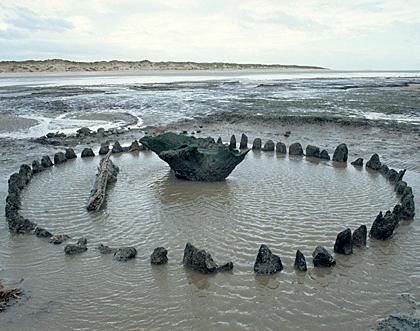Ben Miller
Source - http://www.culture24.org.uk//history-and-heritage/archaeology/art489043-Archaeologists-ring-date-ritual-Bronze-Age-stone-circle-same-year-Norfolk-Seahenge-same-year-sister-site
Two 4,000-year-old Bronze Age monuments were built in burial rites during the same year on a Norfolk Beach

The original Seahenge, on Holme Beach in Norfolk© Norfolk Archaeological Unit
Hidden on a North Norfolk coastal beach, an early Bronze Age stone circle has been dated to the same year as the famous Seahenge monument which once lay 100 metres west of its ritual burial site.
Never excavated and left exposed to sea and weather erosion, archaeologists have used tree ringing to pinpoint the spring or summer of 2049 BC as the date when the formation, which is thought to have held a coffin and later burial mound, was constructed.
It was made of two oak logs, laid flat and surrounded by an oval of oak posts interwoven with oak branches.
An arc of split oak timbers formed the eastern side of the monument, with an outer palisade of split oak timbers surrounding the other elements. Almost all of the elements have been lost or dislodged since 1999, prompting the project to rescue the vital dating information.
“Seahenge is thought to have been a free-standing timber circle, possibly to mark the death of an individual, acting as a cenotaph, symbolising death rather than a location for burial. If it was part of a burial mound, the second circle would have been the actual burial place," says David Robertson, the Historic Environment Officer for Norfolk County Council who ran the Holme II dating project.
“The reasons why the second circle was built are not clear, but it may have formed part of a burial mound.
“The two central logs may originally have supported a coffin. The oval of posts and woven branches could have hidden the coffin from view before a mound was added, with the outer palisade acting as a revetment for the base of the mound.
“As the timbers used in both timber circles were felled at the same time, the construction of the two monuments must have been directly linked.
Sections of seven timbers were originally recovered from the second circle in 2004 and 2013. Experts measured and compared them to tree ring sequences from Great Britain and northern Europe, drawing direct similarities to Bronze Age timbers, including those from Seahenge.
The excavation of the first circle provoked controversy in 1999, nine years before the timbers were reconstructed at Lynn Museum, where they have been on show ever since.
“I never cease to be amazed at the wealth of archaeology and heritage that we have in Norfolk,” admits Toby Coke, the Chairman of the Council’s Environment committee.
“This is an intriguing project that has been painstakingly carried out by the County Council’s in-house experts.
“It will leave us with a wealth of information and very good records about how our ancestors lived in times long past.”
Conservationists are emphasising that the peat beds where the circles were found, on a beach which is part of the coast’s Site of Special Scientific Interest, are vital to birds and local wildlife but vulnerable to disturbance.
“The quality of the wildlife habitat at Holme Dunes is reflected in the fact that it holds nearly every national and international statutory protection available,” says Kevin Hart, the Head of Nature Reserves at the Norfolk Wildlife Trust, urging visitors to resist prying around the obscured circle at a busy time of year for local bird species.
“This second wooden circle is below the high water mark. It is currently buried under sand and is not visible.”

The circle pictured when it briefly re-appeared last June

The second circle at Holme Beach, which scientists now say was linked to Seahenge. Picture: NPS Archaeology.
No future excavations are planned, although the project's results are expected to be published soon.